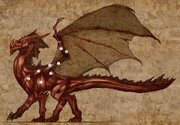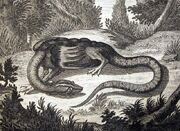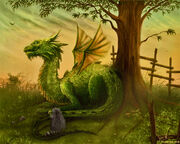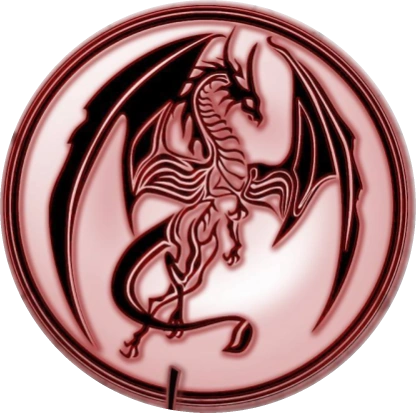No edit summary Tag: rte-source |
No edit summary Tags: Visual edit apiedit |
||
| Line 1: | Line 1: | ||
[[File:Dragon_Muscles.png|thumb|a typical Western Dragon in modern fantasy, from Dungeons & Dragons]]Western Dragons are Dragons with four legs and a pair of wings, i.e. six limbs. This makes them different from any other kind of vertebrate. How this is possible is discussed in the article about [[Flight]]. |
[[File:Dragon_Muscles.png|thumb|a typical Western Dragon in modern fantasy, from Dungeons & Dragons]]Western Dragons are Dragons with four legs and a pair of wings, i.e. six limbs. This makes them different from any other kind of vertebrate. How this is possible is discussed in the article about [[Flight]]. |
||
| − | The term ''Western Dragon'' comes from the Dragonology-series of books, where [[Western Dragon (Dragonology)|it]] labelled all kinds of European dragons<ref name="Drake">Dr. Ernest Drake (2003), '''Dragonology: The complete Book of Dragons''', Templar Publishing plc, ISBN 1-84011-503-3</ref>. In Japan, all dragons from western myths (Western Dragons, Wyverns) are called ''doragon'' (jap. ドラゴン), to separate them from eastern dragons, called ryū (jap. 竜)<ref name="doragon">[[wikipedia:en:Japanese_dragon|Wikipedia: Japanese dragon]]</ref>. |
+ | The term ''Western Dragon'' comes from the Dragonology-series of books, where [[Western Dragon (Dragonology)|it]] labelled all kinds of European dragons<ref name="Drake">Dr. Ernest Drake (2003), '''Dragonology: The complete Book of Dragons''', Templar Publishing plc, ISBN 1-84011-503-3</ref>. The term is also a generic term for describing any and all european dragons in legends and folklore, including but not limited to dragons such as [[Wyverns]], the [[Tarasque]], [[Krak's Dragon]] and Russian and Slavic dragons such as [[Zmey Gorynych]]. In Japan, all dragons from western myths (Western Dragons, Wyverns) are called ''doragon'' (jap. ドラゴン), to separate them from eastern dragons, called ryū (jap. 竜)<ref name="doragon">[[wikipedia:en:Japanese_dragon|Wikipedia: Japanese dragon]]</ref>. |
[[File:Scheuchzer_dragon.jpg|thumb|left|Traditional depiction of a dragon by Johann Jakob Scheuchzer]] |
[[File:Scheuchzer_dragon.jpg|thumb|left|Traditional depiction of a dragon by Johann Jakob Scheuchzer]] |
||
In older Illustrations, for example from the Middle Ages, most dragons resembled winged lizards with talons and serpentine tails, but most times the wings were far to small to actually fly with them. Later, these designs influenced early reconstructions of dinosaurs. |
In older Illustrations, for example from the Middle Ages, most dragons resembled winged lizards with talons and serpentine tails, but most times the wings were far to small to actually fly with them. Later, these designs influenced early reconstructions of dinosaurs. |
||
| Line 7: | Line 7: | ||
When it became known that dinosaurs weren't sluggish, lizardlike animals but stood upright like modern birds and mammals, this influenced fantasy-dragons, so that they were depicted as standing upright, too. Today, most western dragons in fantasy look somewhat dinosaur-like. |
When it became known that dinosaurs weren't sluggish, lizardlike animals but stood upright like modern birds and mammals, this influenced fantasy-dragons, so that they were depicted as standing upright, too. Today, most western dragons in fantasy look somewhat dinosaur-like. |
||
| − | Dragons of this kind are mostly known from European myths, hence the name, and today they are the standard dragons of classical fantasy works (besides the [[Wyvern]]). Especially if there is only one kind of dragon in a work of fiction, it will rarely be anything than a western dragon or wyvern. |
+ | Dragons of this kind are mostly known from European myths, hence the name, and today they are the standard dragons of classical fantasy works (besides the [[Wyvern]]). Especially if there is only one kind of dragon in a work of fiction, it will rarely be anything than a western dragon or wyvern. |
| + | |||
| + | Many mythologists believe dragons, particularly western dragons, were created as the embodiment of ancestral fears humans had for big cats, snakes, birds of prey and bats as they generally resemble some amalgam of these real animals. |
||
[[File:The_Dragon_And_The_Racoon_by_jerry8448.jpg|thumb|Puff, a Standard Western Dragon]] |
[[File:The_Dragon_And_The_Racoon_by_jerry8448.jpg|thumb|Puff, a Standard Western Dragon]] |
||
On the other hand, if there's more than one kind of dragon, western dragons (often called ''True Dragons'') are the most powerful kind of dragons, while other kinds of dragons like wyverns or lindworms are denoted as ''Lesser Dragons'' or ''Draconic Creatures''. Examples are [[Dungeons & Dragons]], where it's distinguished between ''True Dragons'' and ''Draconic Creatures''<ref name="dnd">[http://www.d20srd.org/srd/monsters/dragonTrue.htm The Hypertext d20 SRD: Dragon, true]</ref><ref name="Draconic">[[wikipedia:en:Draconic creature|Wikipedia: Draconic creature]] (englisch)</ref>, or Monster Hunter, where ''Elder Dragons'' are much more powerful than the various kinds of wyverns (''Flying Wyvern'', ''Bird Wyvern'', ''Brute Wyvern''...)<ref name="MonsterHunter">[[w:c:monsterhunter:Category:Monster_Types|Monster Hunter Wiki: Category Monster_Types]]</ref>. |
On the other hand, if there's more than one kind of dragon, western dragons (often called ''True Dragons'') are the most powerful kind of dragons, while other kinds of dragons like wyverns or lindworms are denoted as ''Lesser Dragons'' or ''Draconic Creatures''. Examples are [[Dungeons & Dragons]], where it's distinguished between ''True Dragons'' and ''Draconic Creatures''<ref name="dnd">[http://www.d20srd.org/srd/monsters/dragonTrue.htm The Hypertext d20 SRD: Dragon, true]</ref><ref name="Draconic">[[wikipedia:en:Draconic creature|Wikipedia: Draconic creature]] (englisch)</ref>, or Monster Hunter, where ''Elder Dragons'' are much more powerful than the various kinds of wyverns (''Flying Wyvern'', ''Bird Wyvern'', ''Brute Wyvern''...)<ref name="MonsterHunter">[[w:c:monsterhunter:Category:Monster_Types|Monster Hunter Wiki: Category Monster_Types]]</ref>. |
||
Revision as of 16:42, 23 March 2017

a typical Western Dragon in modern fantasy, from Dungeons & Dragons
Western Dragons are Dragons with four legs and a pair of wings, i.e. six limbs. This makes them different from any other kind of vertebrate. How this is possible is discussed in the article about Flight.
The term Western Dragon comes from the Dragonology-series of books, where it labelled all kinds of European dragons[1]. The term is also a generic term for describing any and all european dragons in legends and folklore, including but not limited to dragons such as Wyverns, the Tarasque, Krak's Dragon and Russian and Slavic dragons such as Zmey Gorynych. In Japan, all dragons from western myths (Western Dragons, Wyverns) are called doragon (jap. ドラゴン), to separate them from eastern dragons, called ryū (jap. 竜)[2].

Traditional depiction of a dragon by Johann Jakob Scheuchzer
In older Illustrations, for example from the Middle Ages, most dragons resembled winged lizards with talons and serpentine tails, but most times the wings were far to small to actually fly with them. Later, these designs influenced early reconstructions of dinosaurs.
When it became known that dinosaurs weren't sluggish, lizardlike animals but stood upright like modern birds and mammals, this influenced fantasy-dragons, so that they were depicted as standing upright, too. Today, most western dragons in fantasy look somewhat dinosaur-like.
Dragons of this kind are mostly known from European myths, hence the name, and today they are the standard dragons of classical fantasy works (besides the Wyvern). Especially if there is only one kind of dragon in a work of fiction, it will rarely be anything than a western dragon or wyvern.
Many mythologists believe dragons, particularly western dragons, were created as the embodiment of ancestral fears humans had for big cats, snakes, birds of prey and bats as they generally resemble some amalgam of these real animals.

Puff, a Standard Western Dragon
On the other hand, if there's more than one kind of dragon, western dragons (often called True Dragons) are the most powerful kind of dragons, while other kinds of dragons like wyverns or lindworms are denoted as Lesser Dragons or Draconic Creatures. Examples are Dungeons & Dragons, where it's distinguished between True Dragons and Draconic Creatures[3][4], or Monster Hunter, where Elder Dragons are much more powerful than the various kinds of wyverns (Flying Wyvern, Bird Wyvern, Brute Wyvern...)[5].
In cryptozoology, there is a similar distiction. In his Blog "The Big Study", "The Professor" categorizes the creatures which are commonly referred as "dragons", and only counts "Major Dragons" (Western Dragons who breathe fire) and "Minor Dragons" (Western Dragons who don't breathe fire) as dragons, while all other mythological and cryptozoological dragons are sepeartely categorized as Great Big Snakes, Sea Serpents, Large four-legged reptilians, Dinosaurs and Pterodactyls.[6]
Sources
- ↑ Dr. Ernest Drake (2003), Dragonology: The complete Book of Dragons, Templar Publishing plc, ISBN 1-84011-503-3
- ↑ Wikipedia: Japanese dragon
- ↑ The Hypertext d20 SRD: Dragon, true
- ↑ Wikipedia: Draconic creature (englisch)
- ↑ Monster Hunter Wiki: Category Monster_Types
- ↑ The Big Study: "DRAGON": A Morass of Confusion (at least to me).
